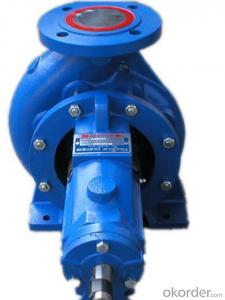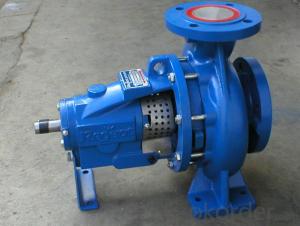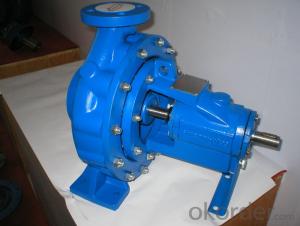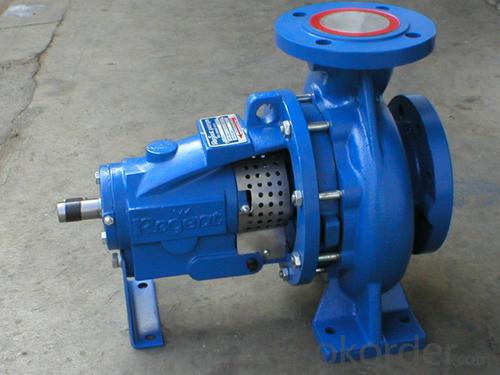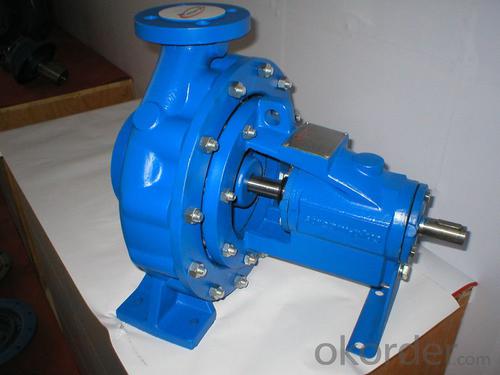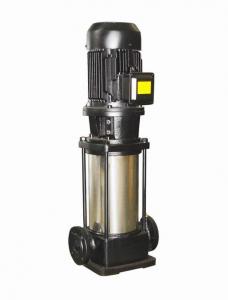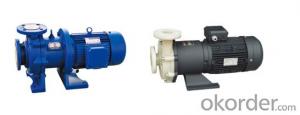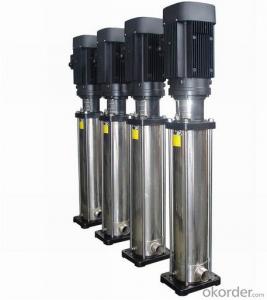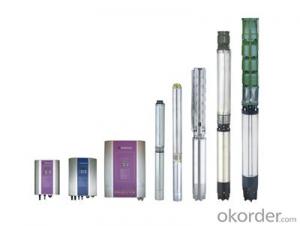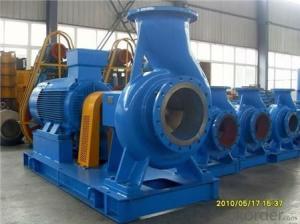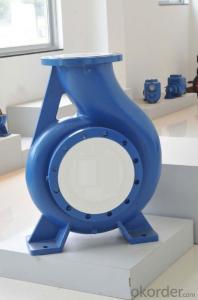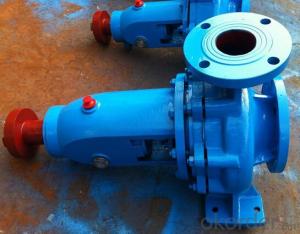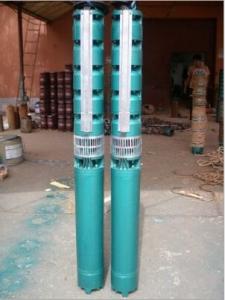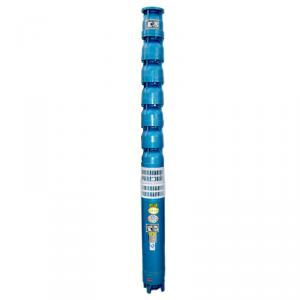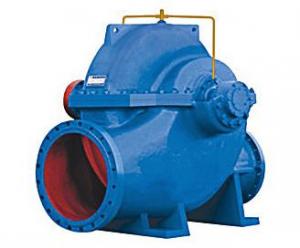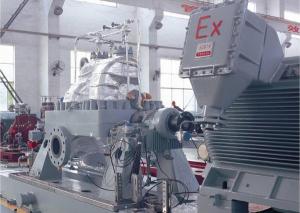DIN 24255 Horizontal Centrifugal End Suction Water Pump
- Loading Port:
- Shanghai
- Payment Terms:
- TT OR LC
- Min Order Qty:
- 1 set
- Supply Capability:
- 10000 set/month
OKorder Service Pledge
OKorder Financial Service
You Might Also Like
End Suction Centrifugal Pump
1.Structure of End Suction Centrifugal Pump Description
End Suction Centrifugal Pump complies fully to the European Standard BS EN733 / DIN24255 of performance and dimensions. They are used for pumping clean water or liquids similar to water, achieving wide application on plants, mines, city water supplies, air-conditioning coolers, firefighting system and irrigation. Pumps of the same model have different performance levels basing on different diameter after impeller trimming. Overall the whole series, there are only four sizes of shaft and five of bearing housing. As long as their bearing housings are of the same size, different pumps can interchange chief parts such as shaft, shaft sleeve, shaft seal, impeller nut, etc.
End Suction Centrifugal Pump is also very easy to be installed and maintained. Back pull-out design, driven through flexible coupling, so that pump casing and motor can remain in position while other spare parts are removed.
2.Main Features of the End Suction Water Pump
• very easy to be installed and maintained
•Back pull-out design
•Driven through flexible coupling
•Customized design is available, OEM and ODM are welcomed.
•Horizontally and vertically installation as different pipeline system
3.End Suction Water Pump Specification
Design | Performance and dimensions referring to BS EN733/DIN24255 |
Structure | Horizontal,Axial,End-Sution,Single-Stage,Single-Sution,Volute,Casing,Back,Pull-out, Centrifugal Pump |
Flange | DIN2501(ISO7005.2/GB/T17241.6 PN1.6)Standard, ANSI B16.5 Class150lb optional) |
Rotation | Clockwise viewing from the drive side |
Casing | Cast Iron Standard, Ductile Iron, Stainless Steel Optional |
Impeller | Bronze Standard ,Cast Iron, Stainless Steel Optional |
Shaft | ASTM420Standard,ASTM304,ASTM316,ASTM1045 Optional |
Shaft Seal | Mechnical Seal, Gland Pakcing Optional |
Flow rate | 2-1100m3/h |
Head | 2-152m |
Speed | 1450 or 2900(50hz),1750 or 3500(60hz) |
Working Pressure | 1.6PMa or 2.0PMa |
4.Picture of End Suction Pump
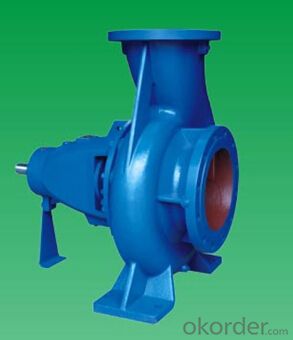
5.FAQ
① What is your product range?
Centrifugal pump, slurry pump, gravel pump, clean water pump, sewage pump, chemical pump, single stage
pump, double suction pump, industry pump, oil pump, paper pulp pump, mud pump, self-priming pump, pipe
water pump, boiler water pump, etc.
② Are you a manufacturer?
Yes, we have been in manufacturing and marketing industry centrifugal pump over 20 years.
③ What information should I let you know if I want to get a quotation?
Pump capacity, pump head, medium, medium temperature, pump material, quantity, if possible, please also provide the pump model you are using now, price will be calculated as per the pump model, if not, we will recommend relevant product for reference.
- Q: My husband has a 78 t-bird and it has steam comming out of it. He replaced the water-pump 2 to 2 1/2 yrs ago. The warranty was only for 1 year should it need to be replaced this soon?
- there is no set time a water pump will last, I have seen them last 200,000 miles and I have seen them last 4,000 miles.
- Q: Relationship between power and flow of sewage pumpFor example, how much power waste water pumps do 1m3/h and 100m3/h need?Best detailed listShow the relationship between power and flow
- There is a formula for motor power = flow (m3/h) * lift head (meter), *9.81/3600/ efficiency (general sewage pump efficiency is about 55%), *1.2 (motor safety factor)For example, 10 tons of flow, lift 10 meters, how much power?N=10*10*9.81/3600/0.55*1.2=0.595. so the motor power we chose should be 0.75KW
- Q: I got a water pump replaced a few month back, ( i own a 95 Honda civic) i have a wierd muffled rattle coming from that part of my car, i was told by a mechanic that it sounds like a bearing is dried out, he says that it wont affect the water pump itself but the ratlle will remain ... is this true . . .
- A bearing is designed to move freely, if it becomes dry there is a very good chance that it will cause it to fail. If i was you i would get it changed as soon as possible because you don`t won`t to be broken down.
- Q: does anyone know the proper way to take the lower gearcase off and install a new water pump kit. it is a 1986.
- This is a simple repair but I'd recommend that you get a service manual, ether a factory manual or one of the generic Seloc manuals. The key things to do are mark the trim tab so you can put it back in the same position after repairs. Drain the oil. Removing the bolt that is in the hole at the back end of the upper housing, as well as all the obvious Nuts. both above and under the cavitation plate. Put the drive in forward gear, which takes the tension off the shift shaft. Once all the nuts and bolt are loose. Jiggle the drive and it will separate from the upper housing. You now have access to the water pump housing. Remove the housing and pull it up and off the d. Shaft. Inspect fully and account for missing impeller blades. When you re assemble Lube the impeller and put the drive key in place and put the impeller in place. Slide the housing down to the impeller. You can use ether th drive shaft or the propeller to turn the drive shaft in a clockwise direction as you apply pressure on the housing, It should slide down over the impeller. Reassemble in reverse order. Slide the drive shaft up into the upper housing turning the D. shaft using the prop to turn the shaft. Watch the water tube slip into the guide tube. Once it's in place put a couple nuts on then check the gear shift to make sure it goes F-N-R. Bolt up and fill with oil. Good Luck!
- Q: NEED WATER PUMP AND HOSES, AND A PRICE QUOTE...
- I have found AUTO ZONE to be my favorite, price, product,and availability! They have knowledgeable people and an online repair guide.
- Q: ok water can't sucked up more than 10 M height in normal atmospheric pressure some well s are deep more than 10 M even some water aquifers are deep more than 200 m what are technologies used to pump water to ground level BQ- how is crude oil pumped from far deep oil wells (some offshore oil platform pump oil from more than 2000 m deep ocean and another several hundred meters deep from sea beds )
- You push it from the bottom. Home water wells have a plastic hose and a power cord along side and the pump is attached to the end and lowered down the hole and pushes the water up the hose. Oil wells are commonly pressurized, but where not that donkey engine you see in oil fields is attached to a long rod or cable and at the bottom of the hole is a pair of valves and a piston and the mechanism pulls the oil in the lower valve and pushes it through the upper valve and that pushes the previous oil up the pipe.
- Q: we live in the country in the warm months and have a portable pump that takes water from a 15 foot deep well. It feeds water to a toilet and a hot water tank mostly and a sink and shower and washer. We put the pump outside the bathroom and need to know how to start it, thanks!
- Lonzo has it right
- Q: What is the relationship between pump power, lift and flow?
- N= QH/1000 gamma ETA gamma, severe liquid, cattle - ETA / m3; efficiency; N- kW; H- head, power meters;Q- volume flow per cubic meter / sec.
- Q: Okay my well water pump keeps turning on and off, i can hear it click on and off. Then the water stops running completely! What is wrong with it?? It has been doing this since last night.
- You have what is called a waterlogged pump system. As Gordon said, all in one sentence, most domestic water pump systems operate by using the water they pull up from the ground to compress the air that's already in the resevoir tank either in your basement or back room. The standard working pressure limits are 20 lbs. on/40 lbs. off, or 30 lbs. on/50 lbs. off. The water is pumped in until the air is compressed to 40 psi., then the pressure switch shuts it down. When you draw water off by turning on a tap somewhere in the home and it eventually gets down to 20 or 30 lbs, whichever your system is set on, the switch calls for more pressure and the pump kicks back on. In older resevoir systems where air and water met, under pressure, eventually the air is absorbed by the pressure until there's no room left for air to be pressurized and the pump tank becomes waterlogged. If you have what is called a bladder tank, there is supposed to be a rubber film stretched across the tank somewhere near the middle to keep the air and the water separated, If that bladder bursts for whatever reason, eventually, you wind up with a more expensive older style water resevoir tank. You can repressurize these tanks, by turning off the electricity to the pump and turning on the house taps. Let them run a good long time, then shut them off, put some air back in the tank via the fixture on top, close everything back up and turn on the system. Let it prime itself and pressurize itself, it should be close to being right, if not right on. Or you can have a new tank installed.
- Q: could you explain the process by which water is pumped out of the ground for purposed such as drinking water or irrigation? Can you put it in terms a high school senior would understand?
- (1) Identify your potential water source through various methods. (2) Drill a small exploratory hole to different depths, test water pressure and water quality. (3) Drill the complete borehole for production and retrieval of the groundwater. (4) Complete the physical well, will a sheath to allow in the water at the wanted levels, solid pluge to keep other levels out. (5) Insert a chemical and physical filter system (small screen membranes, activate charcoal and diatomaceous earth, etc.) (6) Put in the submersible pump and plug it in. (7) The pump is made up of a motor, an intake and a centrifugal pump. It's all sealed so no water can penetrate through. The water is suctioned into the centrifugal pump, which is an impeller type device. The water is then pushed out at a much higher pressure rate than it came in. This is how the pump works from the bottom instead of above ground. The water is sent to the pressure tank, sometimes referred to as a holding tank, and is kept at a constant pressure, so when you turn on your faucet or shower, the water comes out quickly. As you use the water, more water is pumped into the tank and as the pressure drops in the tank, it will automatically come on and pressurize again.
Send your message to us
DIN 24255 Horizontal Centrifugal End Suction Water Pump
- Loading Port:
- Shanghai
- Payment Terms:
- TT OR LC
- Min Order Qty:
- 1 set
- Supply Capability:
- 10000 set/month
OKorder Service Pledge
OKorder Financial Service
Similar products
Hot products
Hot Searches
Related keywords
